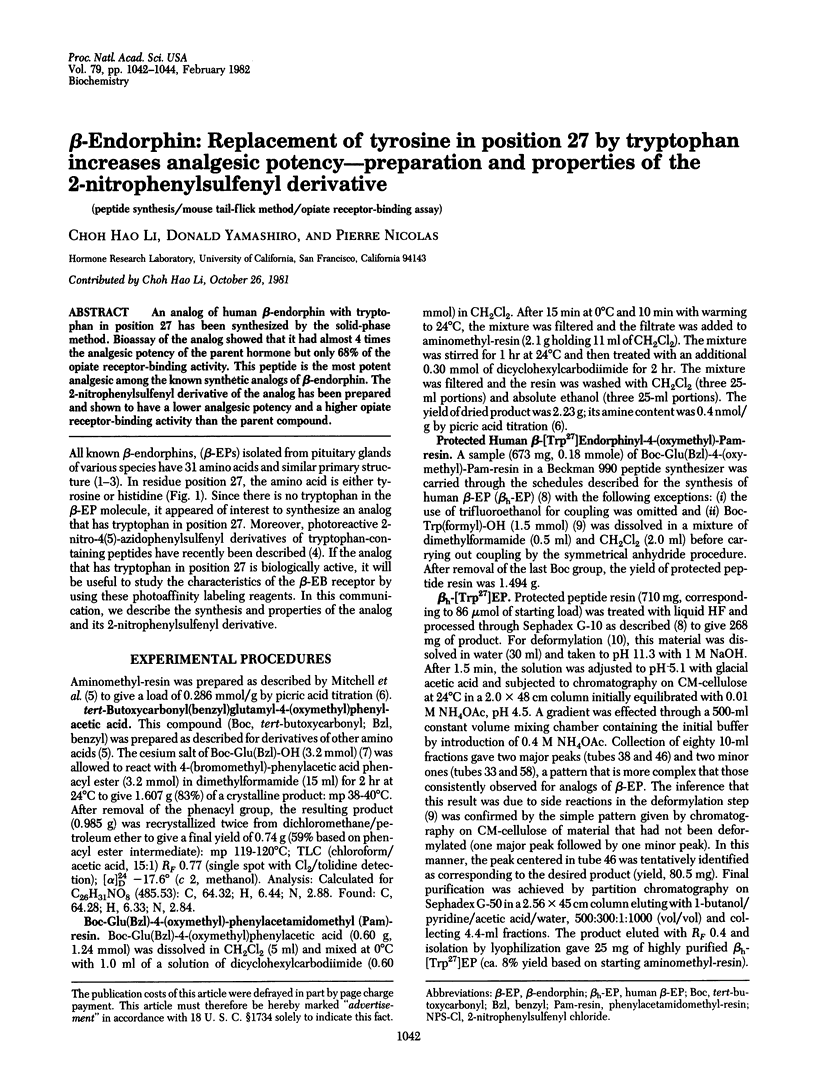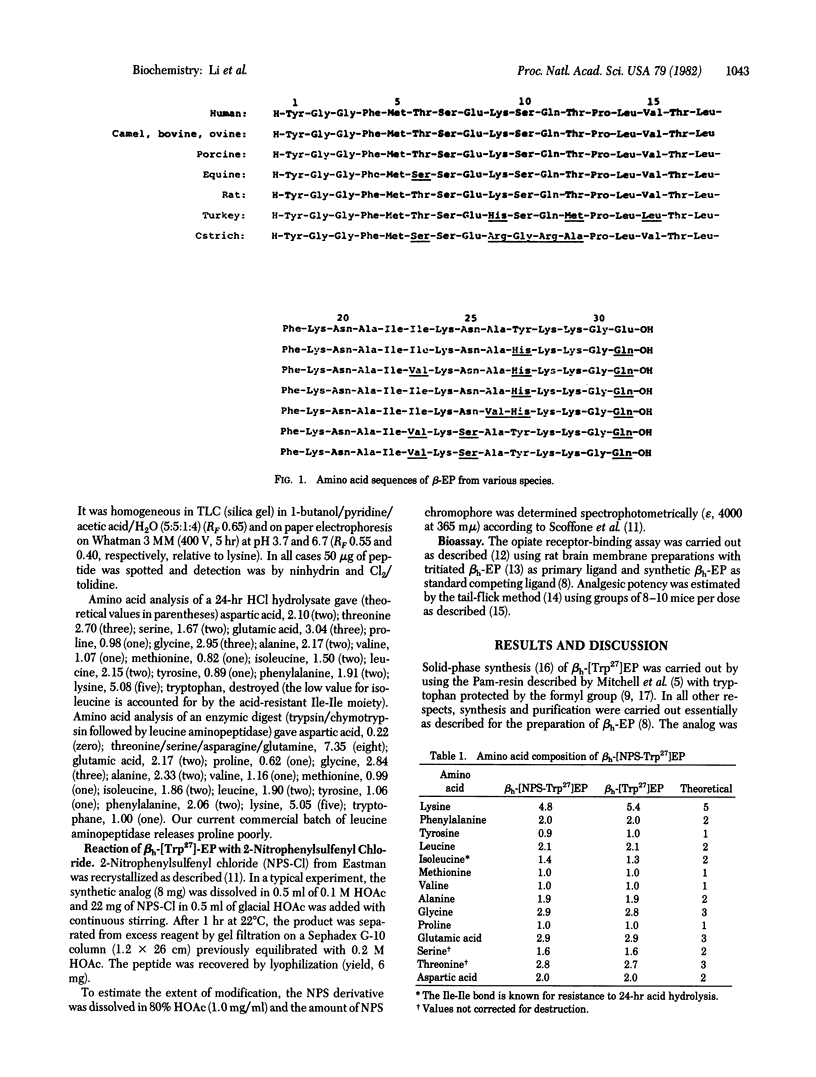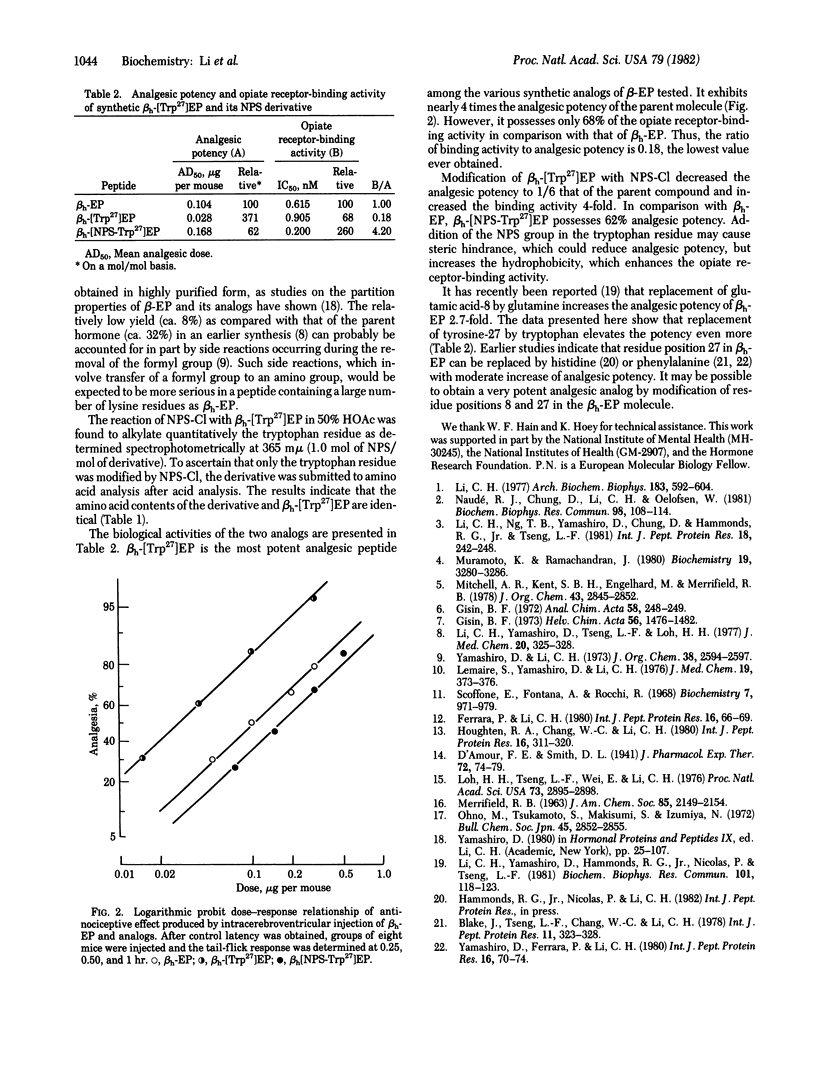Abstract
An analog of human beta-endorphin with tryptophan in position 27 has been synthetized by the solid-phase method. Bioassay of the analog showed that it had almost 4 times the analgesic potency of the parent hormone but only 68% of the opiate receptor-binding activity. The peptide is the most potent analgesic among the known synthetic analogs of beta-endorphin. The 2-nitrophenylsulfenyl derivative of the analog has been prepared and shown to have a lower analgesic potency and a higher opiate receptor-binding activity than the parent compound.
Full text
PDF


Selected References
These references are in PubMed. This may not be the complete list of references from this article.
- Blake J., Tseng L. F., Chang W. C., Li C. H. The synthesis and opiate activity of human beta-endorphin analogs. Substituted at residue positions 27 and 31. Int J Pept Protein Res. 1978 May;11(5):323–328. doi: 10.1111/j.1399-3011.1978.tb02856.x. [DOI] [PubMed] [Google Scholar]
- Ferrara P., Li C. H. beta-Endorphin: radioreceptor binding assay. Relative potency of synthetic analogs with various chain lengths. Int J Pept Protein Res. 1980 Jul;16(1):66–69. [PubMed] [Google Scholar]
- Gisin B. F. The monitoring of reactions in solid-phase peptide synthesis with picric acid. Anal Chim Acta. 1972 Jan;58(1):248–249. doi: 10.1016/S0003-2670(00)86882-8. [DOI] [PubMed] [Google Scholar]
- Houghten R. A., Chang W. C., Li C. H. Human beta-endorphin: synthesis and characterization of analogs iodinated and tritiated at tyrosine residues 1 and 27. Int J Pept Protein Res. 1980 Oct;16(4):311–320. doi: 10.1111/j.1399-3011.1980.tb02592.x. [DOI] [PubMed] [Google Scholar]
- Lemaire S., Yamashiro D., Li C. H. Synthesis and biological activity of camel and bovine beta-melanotropins. J Med Chem. 1976 Mar;19(3):373–376. doi: 10.1021/jm00225a006. [DOI] [PubMed] [Google Scholar]
- Li C. H., Ng T. B., Yamashiro D., Chung D., Hammonds R. G., Jr, Tseng L. F. beta-Endorphin: isolation, amino acid sequence and synthesis of the hormone from horse pituitary glands. Int J Pept Protein Res. 1981 Sep;18(3):242–248. doi: 10.1111/j.1399-3011.1981.tb02978.x. [DOI] [PubMed] [Google Scholar]
- Li C. H., Yamashiro D., Hammonds R. G., Jr, NIcolas P., Tseng L. F. beta-Endorphin: replacement of glutamic acid in position 8 by glutamine increases analgesic potency and opiate receptor-binding activity. Biochem Biophys Res Commun. 1981 Jul 16;101(1):118–123. doi: 10.1016/s0006-291x(81)80018-6. [DOI] [PubMed] [Google Scholar]
- Li C. H., Yamashiro D., Tseng L. F., Loh H. H. Synthesis and analgesic activity of human beta-endorphin. J Med Chem. 1977 Mar;20(3):325–328. doi: 10.1021/jm00213a001. [DOI] [PubMed] [Google Scholar]
- Li C. H. beta-Endorphin: a pituitary peptide with potent morphine-like activity. Arch Biochem Biophys. 1977 Oct;183(2):592–604. doi: 10.1016/0003-9861(77)90395-2. [DOI] [PubMed] [Google Scholar]
- Loh H. H., Tseng L. F., Wei E., Li C. H. beta-endorphin is a potent analgesic agent. Proc Natl Acad Sci U S A. 1976 Aug;73(8):2895–2898. doi: 10.1073/pnas.73.8.2895. [DOI] [PMC free article] [PubMed] [Google Scholar]
- Muramoto K., Ramachandran J. Photoreactive derivatives of corticotropin. 2. Preparation and characterization of 2-nitro-4(5)-azidophenylsulfenyl derivatives of corticotropin. Biochemistry. 1980 Jul 8;19(14):3280–3286. doi: 10.1021/bi00555a028. [DOI] [PubMed] [Google Scholar]
- Naudé R. J., Chung D., Li C. H., Oelofsen W. beta-Endorphin: primary structure of the hormone from the ostrich pituitary gland. Biochem Biophys Res Commun. 1981 Jan 15;98(1):108–114. doi: 10.1016/0006-291x(81)91876-3. [DOI] [PubMed] [Google Scholar]
- Scoffone E., Fontana A., Rocchi R. Sulfenyl halides as modifying reagents for polypeptides and proteins. I. Modification of tryptophan residues. Biochemistry. 1968 Mar;7(3):971–979. doi: 10.1021/bi00843a014. [DOI] [PubMed] [Google Scholar]
- Yamashiro D., Ferrara P., Li C. H. beta-endorphin: synthesis of analogs with extension at the carboxyl terminus with high radioreceptor binding activity. Int J Pept Protein Res. 1980 Jul;16(1):70–74. doi: 10.1111/j.1399-3011.1980.tb02937.x. [DOI] [PubMed] [Google Scholar]
- Yamashiro D., Li C. H. Protection of tryptophan with the formyl group in peptide synthesis. J Org Chem. 1973 Jul 27;38(15):2594–2597. doi: 10.1021/jo00955a004. [DOI] [PubMed] [Google Scholar]


